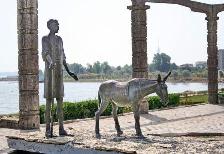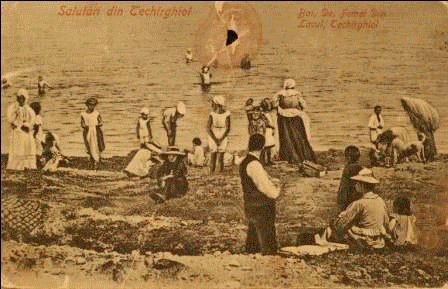Overview | History | Population |Location | Touristic Attractions | Tourism Infrastructure | Touristic Programs | Touristic Destinations | Associations | Accomodation
Asinus vulgaris techirghiolensis*, or Techir´s donkey… this is how the legend first started
… once upon a time, a crippled and blind old man and his donkey reached, by mistake, the shore of this lake. For countless hours, the old man strived to get out of t he smelly mud, but the stubborn steed did not want to move, as if that shore was putting a secret spell on him. It was with great wonder and joy when the old man realized, as he got out of the lake, that his eyes could distinguish again a beam of light, and his feet, so forceless for such a long time, started to obey him. As for his wise donkey – the bad wounds on his back had healed, and his body seemed to enjoy a new youth. When they found out about this miraculous healing, a lot of people rushed on the lake shore, taking baths and putting mud all over their bodies, to be cured. And indeed, so many miracles happen there – crippled people start to walk again, stiff bones regain their youth, women regain fertility, and chest pain is relieved.
he smelly mud, but the stubborn steed did not want to move, as if that shore was putting a secret spell on him. It was with great wonder and joy when the old man realized, as he got out of the lake, that his eyes could distinguish again a beam of light, and his feet, so forceless for such a long time, started to obey him. As for his wise donkey – the bad wounds on his back had healed, and his body seemed to enjoy a new youth. When they found out about this miraculous healing, a lot of people rushed on the lake shore, taking baths and putting mud all over their bodies, to be cured. And indeed, so many miracles happen there – crippled people start to walk again, stiff bones regain their youth, women regain fertility, and chest pain is relieved.
Archeological findings are proofs for the existence and continuity of people on these lands. The history of habitation in the region goes back to the Neolithic, the Techirghiol location being included in the second phase of the Hamangia-Cernavodă culture. The archeological research made by Vasile Pârvan as early as 1924 tried to establish the history of this region.
There are places in town that bear archeological traces of the Hamangia-Cernavodă culture and historical imprints: coins from the Roman Empire, documents from the Ottoman period, acts belonging to Mihail Kogălniceanu, the house and asylum built by Constantin Tănase, but also the family holiday houses of Mircea Eliade, Cezar Petrescu, Tudor Arghezi, Jean Constantin.
The first written records about the therapeutical benefits of mud date back to 1854, when an Ottoman commander used it to cure its ailing arm. Techirghiol is known as spa resort since 1899. It was the year when the Techirghiol Maritime Asylum was inaugurated, with beds and facilities for mud baths.
Techirghiol became a holiday route for the intellectuals of the  time. In parallel with the development of Mamaia resort, Techirghiol became a favorite destination for the upper class, people interested in the therapeutical benefits of the “cold baths” lake. Bohemians moved to Techirghiol, and right after the First World War Eforie became the favorite destination for rich people. Artists came from Dobrogea to paint, writers – like Ionel Teodoreanu, for example (who used to find retreat at Techirghiol, with his wife and children) – tried to write, and actors had their headquarters at Carmen Sylva (Eforie Nord). The families of writers Cezar Petrescu and Tudor Arghezi were summer guests of the resort.
time. In parallel with the development of Mamaia resort, Techirghiol became a favorite destination for the upper class, people interested in the therapeutical benefits of the “cold baths” lake. Bohemians moved to Techirghiol, and right after the First World War Eforie became the favorite destination for rich people. Artists came from Dobrogea to paint, writers – like Ionel Teodoreanu, for example (who used to find retreat at Techirghiol, with his wife and children) – tried to write, and actors had their headquarters at Carmen Sylva (Eforie Nord). The families of writers Cezar Petrescu and Tudor Arghezi were summer guests of the resort.
Techirghiol was a source of inspiration and treatment for the high class of the 20th century.
Camil Petrescu set part of the action of his novel The Bed of Procrustes in Techirghiol, action placed between 1926 and 1928, and put into words the essence of the characters of that time.
Other historical references
In 1388, Dobrogea was first united with Wallachia, under the reign of Mircea cel Bătrân (Mircea the Elder). At the half of the following century, Dobrogea gets under Ottoman occupation. The first documentary mention about Techirghiol is from 1560, when Tekfür-köy was named, and appears in the firmans issued by Suleiman the Magnificent to the Moldavian ruler.
On the 1st of December 1878, the Romanian troops enter Dobrogea, moment that is considered, de facto, the annexation of the Dobrogea province to the country.
One of the new “inhabitants” of Techirghiol, after the land reform, was also Mihail Kogălniceanu, who bought land and real estate around the lake. He also built a public fountain in Techirghiol, and an Orthodox chapel in Tuzla.
One of the prominent inhabitants of Techirghiol was Mircea Eliade; his parents owned a holiday house in Techirgiol – Villa Claudia – since 1906.
Another distinguished benefactor was the great artist Constantin Tănase. He commited to build a sanatorium for artists (Villa Scena), and donated money for the building of the Community Centre and the St. Elijah Church.
In 1894, the Ministry of Agriculture and Estate sold 100 ha on the lake shore to the benevolent society The Board of Civil Hospitals from Bucharest. This represents also the first step towards building up the spa resort around the lake. This was the cornerstone of what would become Techirgiol-Eforie, and later on the nowadays town of Eforie Nord.
Constantin Băjenaru should also be remembered, as one of the first mayors of Techirghiol, who made serious efforts to make the town look more beautiful, clean and prosperous, as a spa resort.
In 1931, the Heroes Monument was inaugurated in the “General I. Dragalina” Square, in the memory of the soldiers who gave their life in the war of 1916 – 1918 (Techirghiol and the surrounding area paid their tribute with 176 people lost in battles).
*Bibliography – Monograph of Techirghiol, by Aurelia and Ștefan Lăpușan*